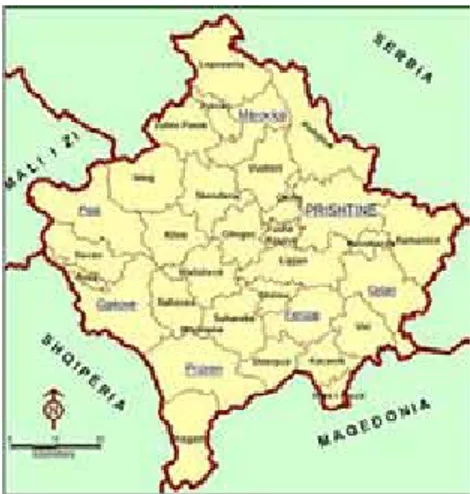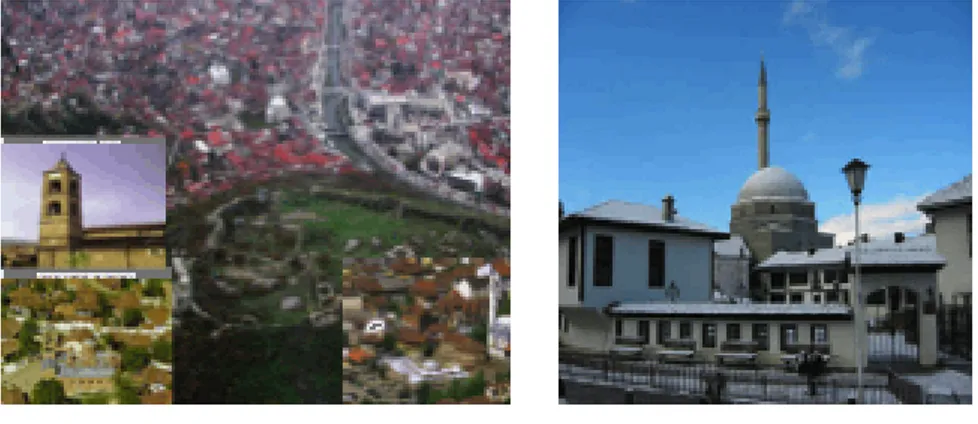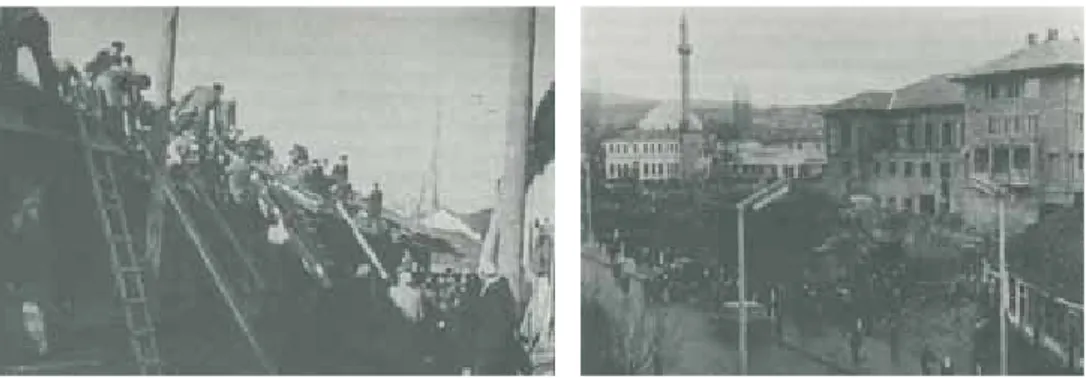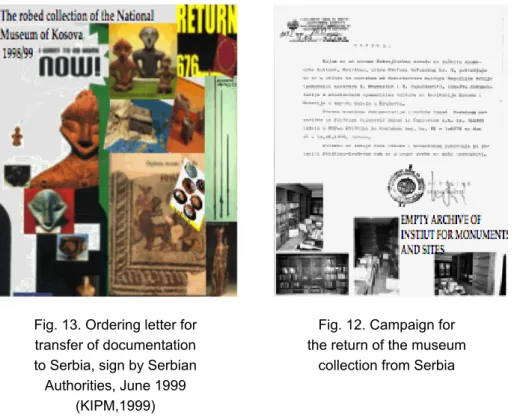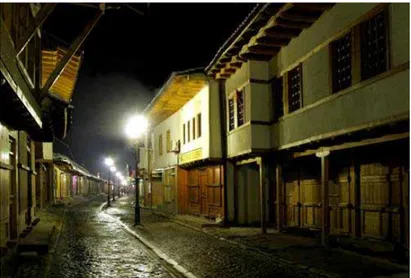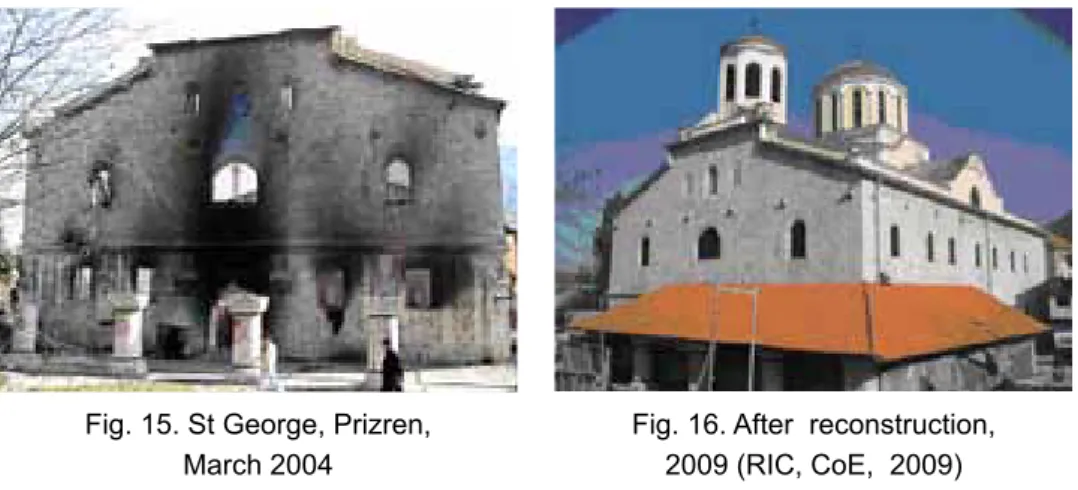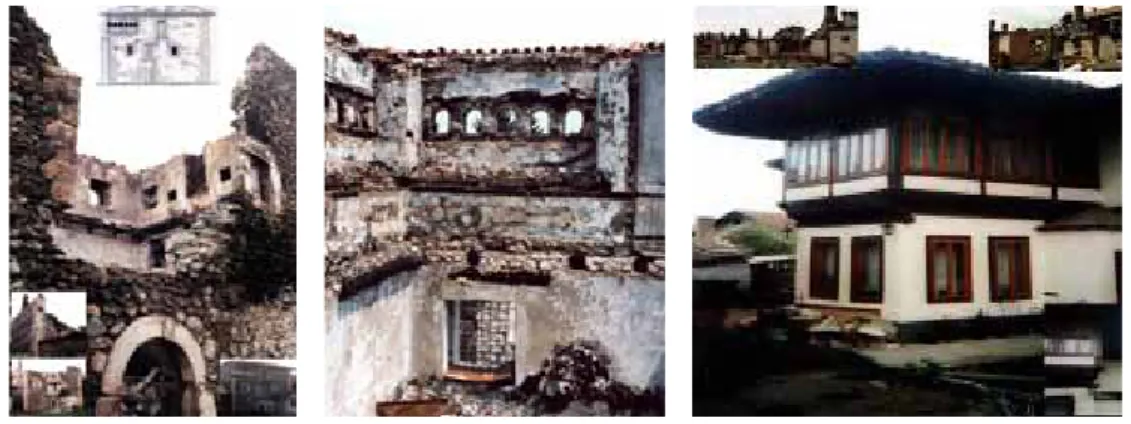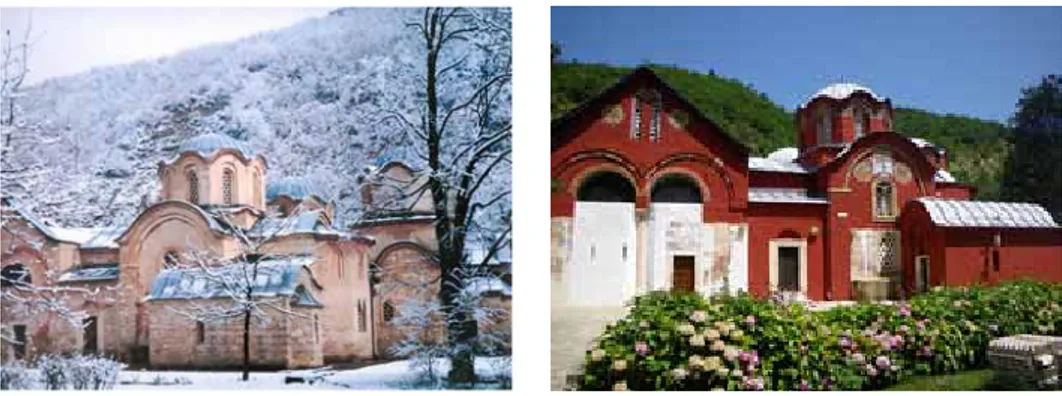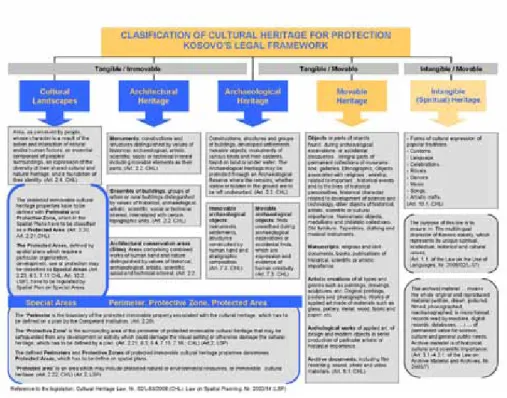Dip.Ing. Gjejlane HOXHA*
1Abstract
The paper will explore the treatment and conservation approaches of Kosovo’s cultural herit-age properties. Furthermore it will describe the legal definition and manherit-agement mechanisms, underline the demands for development and modernization of administrative mechanisms re-sponsible for managing the protection and enhancement of cultural heritage, as well profes-sional standards, education and training programs for conservation, according to international principles.
Introduction
The Republic of Kosova is situated in the heart of Balkans. It covers an area of about 10,000 km², populated by over 2 million people (according to 1998 estimates). 90% of the population is Albanian, whereas 10% is Serbian, Turkish, Bosnian and other ethnic groups. Albanian and Serbian are the two key languages. With regards to religion, the majority of the population is either Islam or Catholic, whereas the Serbian community is Orthodox. Its capital city is Prishtina. (MESP & ISP, 2010,p.19)
* Conservation Architect, Kosova Kültürel Miras Konseyi (Kosova Council for Cultural Heritage), KOSOVA CUMHURİYETİ, gjejlaneh@gmail.com.
Today, the cultural landscape of Kosovo has changed dramatically from
60 years ago, and much of what has been left gives evidence of Kosovo’s
diverse cultural traditions. The territory still contains unique and dynamic
records dating from the Neolithic, Roman, Byzantine, Ottoman and further
periods.
LEGAL PROTECTION OF CULTURAL
HERITAGE IN KOSOVA
Fig. 1 Map of Kosovo (Albanian Diaspora Chamber of Commerce, 2011)
Throughout the past, the environment of Kosovo has been shaped by people responding to the surroundings they inherit and embodies the aspirations, skills and investment of successive generations. Its cultural landscape contains unique and dynamic records dating from the Neo-lithic, Roman, Byzantine, Ottoman and further periods. (MCYS, 2010).
The domination of Ottoman Empire for five centuries influenced on social lifestyle, economic development, cultural, religion, architecture and settlements pattern. Therefore, the ottoman architecture was dominated almost in every historic core of Kosova towns. (MCYS, 2010)
Fig.4,5,6 Carsi Mosque, Fatih Hamam and Mosque, (c XV) Pristinë Fig. 2. Old Pristine 1933-1950
(KIPM, 2012)
Fig. 3. Historic Center of Pristine - pattern of Ottoman period
Until the mid-twentieth century, Kosovo’s cultural heritage symbolized peaceful coexistence. The different ethnic and religious groups preserved the artistic, aesthetic and social values of its rich and multi-cultural heritage over generations as part of their deeply-rooted lifestyles.
The occupations and conflicts have also been part of our history. Our traditional rich cultural heritage such as archaeological sites, well-preserved historic urban centers, traditional houses and religious buildings, libraries, archives, museums and other cultural and educational institu-tions, for a long period have been systematically neglected and intentionally attacked, violated, looted and destroyed. (Riedlmayer 2000 a, b; Frederiksen and Bakken 2000)
Today, the cultural landscape of Kosovo has changed dramatically from 60 years ago, and much of what has been left gives evidence of Kosovo’s diverse cultural traditions. The territory still contains unique and dynamic records dating from the Neolithic, Roman, Byzantine, Ottoman and further periods.
Fig. 9. Significant cultural heritage features (By author, 2011) Fig. 7. Historic Center of Prizren,
2000 (CoE, 2000)
These features of the past represent the significant cultural heritage of Kosovo and are impor-tant from a historical, aesthetic, architectural and social perspective. In addition to that, these assets are bedrock for the sustainable development, which ensures continuity in the use of buildings and continuity of endeavor from the past.
Conservation approaches in the past
In general terms, the cultural heritage assets of Kosovo are in a precarious and most vulner-able situation arising from the dire consequences of armed conflicts of 1998/1999, the natural processes of age and decay greatly exacerbated by environmental pollution, significant long-term neglect and a chronic lack of policy, strategies, proper inventory, conservation plans and funds for preservation and rehabilitation according to the international principles and standards. (KCCH, 2010)
Period of 1947-1998- Apathy and subjective state evaluation
It was not until after the Second World War that cultural heritage management as a state-organ-ized activity was established in Kosovo. (Riza, 2005) In the second half of the 20th century (c. 50
years) when Kosovo was part of the Yugoslavian state and came under the Serbian domination, cultural heritage was re-defined and managed according to the standards set by the political regimes. After the last war, circa 3000 cultural heritage sites have been identified in Kosovo between 1999 and 2005.
However, between 1947 and 1990, only 425 monuments and sites were officially listed. (MCYS, 2010) These included 96 archaeological sites, 16 cemeteries, 116 secular monuments and 174 religious sites, 139 of which were Serbian Orthodox churches or monasteries. Only 32 Islamic religious monuments were listed during this period, there was a strong bias towards Orthodox religious sites. (Riza, 2005) Since listed sites were researched, promoted and maintained better than unlisted sites, this bias had a direct effect on their survival.
The limited evaluation criteria and policies directed towards such a small number of cultural her-itage monuments and sites, demonstrated an ignorance or disregard of the cultural herher-itage di-versity in the territory and a failure to embrace the implications of Article 1 of the Venice Charter for the Conservation and Restoration of Monuments and Sites (ICOMOS 1964): ‘The concept
of an historic monument embraces not only the single architectural work but also the urban or rural setting in which is found the evidence of a particular civilization, a significant development or an artistic event. This applies not only to great works of art but also to more modest works of the past which acquired cultural significance with the passage of time’.
Through the ignorance and apathy of politicians, many valuable assets have been ignored, threatened and lost. Already in 1998, before the destructions of the war began, the selective cultural heritage state policy had changed the cultural landscape of Kosovo in a dramatic way. Classified chronologically and stylistically, the worst systematic devastation has suffered by properties dating from prehistory and antiquity, followed by those of the Ottoman period of the 15th-20th centuries. (Riedlmayer, 2000a)
Fig. 10,11. Destruction of the historic centre of Pristine after 1950 (IPMP, 2012)
The built cultural heritage of Kosovo had already dwindled through neglect, and the subsequent war destroyed much of what was left, beyond retrieval. The urban historic centres of Prishtina, Prizren, Peja, Gjakova, Mitrovica, Gjilan and Decan, as well as more than 300 archaeological sites and traditional historic nuclei in rural areas were devastated, along with many individual buildings that the Kosovo Institute for the Protection of Monuments had evaluated as embody-ing significant cultural heritage values.
Period of 1998-1999- Intentional destruction of traditional built environment
In the spring of 1998 until the summer of 1999, Kosovo was exposed to the dramatic armed con-flict and ethnic cleansing. Around one million Kosovars were driven from their homes and thou-sands were killed by Serbian forces. Their houses and traditional cultural heritage monuments and sites were looted and destroyed. (Riedlmayer 2000a, b; Frederiksen and Bakken 2000)
Fig. 11.Destructionof monuments and sites by Serbian forces, Kosovo March-June 1999 (KIPM, 1999)
The large-scale destruction, both in urban and rural areas, resulted in loss or damage of thou-sands of cultural heritage monuments and sites, amongst them more than 200 mosques, a dozen of Catholic churches and hundreds of other traditional houses and historic buildings and sites. (Riedlmayer, 2000a)
The destruction of the cultural heritage in Kosovo has been classified as a crime against human-ity. (ICTY, 2011)
The war has affected not only the built cultural heritage, but also Kosovo’s museum collections and archives. On the eve of war, in the late 1998, more than 1200 of the most valuable items from the collections of the Kosovo Museum in Prishtina and from regional museums in Prizren and Mitrovica were sent to Belgrade with the pretext of an exhibition. (Fig.8) (Kosovo Museum, 2003) The entire documentation of the country’s monuments and sites from the central archive of the Kosovo Institute for the Protection of Monuments was sent to Serbia in June 1999. (KIPM, 1999)
More than a dozen years later, requests for the return of museum collections and documenta-tion continue to be ignored. Only one archaeological exhibidocumenta-tion object as Goodness on the Throne has been return. (Kosovo Government, 2011)
Fig. 13. Ordering letter for transfer of documentation to Serbia, sign by Serbian Authorities, June 1999
(KIPM,1999)
Fig. 12. Campaign for the return of the museum
Period of after the war –Recovering
Fig. 14 Reconstruction of the Old Bazar in Gjakova, 2003 (greengopost, 2011)
In the period following the 1998-99 war, during the reconstruction period, the assessment and consolidation of the living environment. In the domain of cultural heritage various activities has been carried out by international support, and some results have been achieved.
The number of projects has been implemetied by local and international institutions, mainly by USA NGO, CoE, EC, AER, UNMIK, CHwB Sweden, Intersos, Italy, US Office in Prishtina, Turk-ish Government, est. This support has had a number of beneficial effects such as initial integra-tion of cultural heritage in the post-war reconstrucintegra-tion of damaged or destroyed settlements; the start of a compilation of a register and inventory of cultural heritage monuments and sites for the entire territory; building capacity on management, technical skills, inter-ethnic and inter-cultural cooperation; recording endangered monuments and sites; promoting the diversity of cultural heritage; integrating cultural heritage conservation into spatial and urban or rural development; developing new legislation; initiation on developing new policies and strategies for conservation, as well as the preparation of the Priority Intervention Lists and Feasibility Studies.
However, none of these activities came close to meeting the actual demands and real needs of the post-war situation. Of c.1000 sites that were destroyed or damaged during the conflict, only few of them were professionally restored or reconstructed such as five traditional stone houses, four mosques, two old mills, one hammam and a sequence of the old bazaar in Gja-kova. (KCCH, 2010a)
March Riots 2004 –Damages of more cultural heritage monuments and sites
Regrettably, damage and destruction of cultural heritage sites did not end even though the war ended in June 1999. During an outbreak of ethnic riots in March 2004, additional cultural age and religious sites were damaged. In the riots of March 2004, 34 religious and cultural herit-age sites (Orthodox churches, monasteries, cemeteries, funerary chapels and some traditional houses were attacked. (CoE, 2004) The damaged orthodox monasteries and churches have been repaired or reconstructed by the Government of Kosovo with the international support. (RIC, CoE, 2009)
Restoration and post-conflict reconstruction works were hectic, especially after the riots of March 2004. Since the events of March 2004, the protection of cultural heritage has been given a high profile in the national and international political agenda, with much attention given to the protection of Orthodox churches.
The damaged cultural heritage monuments and sites during the war 1998/99 are still neglected, in danger and in a very alarming stage of decay. In addition to that, the ongoing conserva-tion activities proceed without supervision, elaborated and coordinated conservaconserva-tion policy and planning. Only one Conservation Development Plan has been prepared for historic areas at risk, enabling the consolidation of a small number of monuments which were in a particularly bad condition. (KCCH, 2010)
DEVELOPMENT OF GOALS AND OBJECTIVES SURVEY AND ANALYSES OF PRIZREN STUDY DATA COLLECTION
FORECASTING
EVALUATION AND PLANNING DECISIONS OF THE PRIZREN CONSERVATION PLAN
FORMULATING CRITERIA FOR DESIGN
PLANNING DECISIONS RELATED TO LAND AND BUILDING USES
PRELIMINARY PLAN DESIGN
PRELIMINARY SCHEME FOR CONSERVATION AND DEVELOPMENT PLAN
PLAN DESIGN PLAN EVALUATION IMPLEMENTATION
Fig. 17. Prizren Historic Area Conservation and Development Plan (CHwB & ITUT, 2008)
The neglected cultural heritage monuments and sites, damaged during the war 1998/99
Even today more than a decade after the armed conflict, a large number of cultural heritage monuments and sites in urban and rural areas, including historic centres, religious and
tradi-Fig. 15. St George, Prizren, March 2004
Fig. 16. After reconstruction, 2009 (RIC, CoE, 2009)
tional residential architecture that were destroyed and damaged during the war remain beyond adequate care, treatment or technical assessment.
Fig. 18. Traditional houses in Decan and Vushtri, 2010 (KPM, 2007)
The historic and archaeological sites are left on the mercy of time and the destructive interven-tions of developers.
Fig.19,20. Archaeological site-antique Castle, Vushtrri
Fig.23. Archaeological Site, Harilaq, Prishtinë inappropriate consolidation, 2009
Fig.24 Archaeological Site, Fortres Artana /Novo Brdo – Dilapidation, 2011
Fig.25,26,27. Historic core, traditional houses (c XIX) and Sinan Pasha Mosque (c XVI ) Prizren, 2012
The public and professional access in the protected cultural heritage properties such as mon-asteries and orthodox churches in Kosovo are restricted both for public institutions and profes-sionals, enabling the inspection. The conservation interventions are ongoing without control, effecting authenticity and integrity of protected cultural heritage properties.
Fig.28. Left: Patriarchate of Pejë, 2006; Right: Inappropriate intervention in 2009, lost of authenticity of the WHS (UNESCO, 2009)
The documentation taken from Kosovo Institute for Protection of Monuments and more than thousand of archaeological and ethnological objects taken from the collections of Kosovo’s Na-tional Museum have not yet been returned by Serbia. (Kosovo Government, 2011)
The completion of the legal List of Cultural Heritage, Professional Guidelines for conservation, and inclusion of the cultural heritage in the territorial urban and rural planning and consolidation of funds are imperative of today. (KCCH, 2010b)
Protection efforts - conservation challenges today
Kosovo has lost a lot of its cultural heritage in the past sixty years, but we still have much to preserve and a lot to contribute to the collective world heritage.
The aim of promoting and conserving whatever cultural heritage is left has a particular reso-nance in its positive message.
Kosovo’s cultural heritage consists of a variety of properties within a range of built settings.It includes architectural and archaeological heritage, together with natural elements, important monuments, groups of buildings and historic areas (the man-made environment as a whole) and the intangible heritage. These cultural heritage assets belong to all mankind. They are part of the common heritage of all civilizations, and their loss is irreplaceable. (Kosovo Assembly, 2008)
Fig.29. Archaeological Site Ulpiana, Pristinë
Fig. 30.Traditional restaurant in historic core, Prizren
The diverse cultural heritage expressions are remarkable and significant resources of Kosovo. With a view to improving the quality of life and living environment of local communities, the pres-ervation of cultural heritage assets has begun to be recognized as one of the valuable sources for the overall political, social, economic and ecological regeneration.
Since the preservation of cultural heritage is a shared responsibility of all people living in Ko-sovo, irrespective of race, ethnicity, gender or religious affiliation, the cultural heritage potential must be regarded as a vital mechanism in the development of improved mutual understanding in a cohesive civil society, rather than a focus for conflict. (CoE, 2004) Furthermore, from be-ing a challenge, the preservation would become an opportunity for promotbe-ing local economic development. (CoE, 2005)
Considering the breadth of meanings in this context, in the Constitution of the Republic of Ko-sovo, Article No. 58.5 states that: ’The Republic of Kosovo shall promote the preservation of the
cultural and religious heritage of all communities as an integral part of the heritage of Kosovo. The Republic of Kosovo shall have a special duty to ensure an effective protection of the entirety of sites and monuments of cultural and religious significance to the communities’. (Kosovo
As-sembly, 2008)
Legal frame
Towards the preservation, revitalization and promotion of exiting cultural heritage in Kosovo, consistently with Kosovo’s Constitution and inspired by international conventions, recommen-dations and guidance, the following legal mechanisms have been put in place:
- Law on Cultural Heritage, No.02/L-88, 9 Oct 2006; - Law on Spatial Planning, No.2003/14, 2003; - Law on Archive Material and Archives No. 2003/7;
- Law on Special Protective Zones, No. 03/L-039, 20 Feb 2008; - Set of 7 Cultural Heritage Regulations, 2008;
The purpose of the laws
The laws emphasize objectives that the conservation of cultural heritage and its sustainable use have a human development and quality of life as their goal. The promotion of cultural herit-age protection is a central factor in the mutual supporting objectives of sustainable develop-ment, cultural diversity and contemporary creativity. Protection includes properties which are significant for its historical, artistic, architectural, archaeological, social, scientific, economic or technical interest.
According to the Cultural Heritage Act, the cultural heritage is classified in the following five categories:
- The architectural heritage (monuments, group of building and sites);
- The archaeological heritage (monuments, group of buildings, sites and archaeological re-serves);
- The movable heritage; - The intangible heritage;
Fig. 31. Legal classification of cultural heritage properties (KCCH, 2011)
In the surrounding of immovable cultural heritage properties the enhancement of the environ-ment have to be undertaken. The protected immovable cultural heritage properties, with clearly defined Perimeter and Protective Zones (Buffer Zones) have to be included in the spatial and urban plans as Protected Areas. The defined protected areas which require a particular or-ganization, development, use or protection may be classified as Special Areas and should be regulated by the Spatial Plan on Special Areas. (KKCH, 2011)
The different cultural heritage types and categories have to be conserved in a balanced manner. This presupposes the implementation of all measures having as their final goal the continuity of heritage, its maintenance in an appropriate environment, built or natural, and its modification and adaptation to the needs of society. Its real conservation will be achieved if the conservation is one of the main objectives of urban and country planning and development.
In the practical terms, the laws define the statutory measures by which the various actors should protect the cultural heritage in five primary areas, such as the architectural, archaeological, movable, intangible and the cultural landscapes according to certain minimum standards. These include the identification, documentation, evaluation and selection of properties to be protected; ancillary financial and fiscal measures to provide support for maintenance and res-toration; authorization and supervision procedures on preventive, disfigurement, dilapidation or demolition, sanction provisions, integrated conservation policies, and the mechanisms to encourage consultation and co-operation in the various stages of the decision –making process.
Fig.32. Flow charter on investigations, decisions and actions (Australian ICOMOS, 1999)
Identification of properties for protection
The legal procedures and criteria for identification and selection of cultural heritage properties to be protected demand the creation and maintenance of an inventory. In order to complete the inventory as a tool on planning and decision for protection, the legislation requires inclusion of five categories of cultural heritage such as the architectural, archaeological, movable, intangible and cultural landscapes. The flowchart of the inventory system, with reference to the Cultural Heritage Law and Regulation No. 5/2008, illustrates the process’ functions, the stakeholders and their responsibilities.
The establishment of the inventory system is still underway and some gaps need to be filled in order to ensure an effective performance in line with technical standards. (KKCH, 2011)
Institutional frame in integrated system
The legislation applicable to the cultural heritage is not separate from the administrative organi-zation that implements it.
Fig.34. Public administration system on cultural heritage protection (KCCH, 2011) The main authority for the adaptation of legislation, national policies, Spatial Plan, Spatial Plans of Special Areas, resolutions and other general acts is the Kosovo Assembly with the commit-tees in charge for the Spatial Plan, Agriculture and Rural Development, Education, Science, Technology and Media.
The main stakeholders responsible for the management and implementation of regulations and standards on the cultural heritage protection are:
- Kosovo Council for Cultural Heritage (KCCH), established under the Cultural Heritage Law, article 4.8,
- Prime Minister Office;
- Ministry of Culture, Youth and Sport (MCYS)/ Department of Cultural Heritage (DCH); - Ministry of Environment and Spatial Plan (MESP);
- National Archive, Regional and municipal archives;
- National Museum; Institute of Archaeology; Kosovo Institute for the Protection of Monu-ments and regional branches in Pristine, Prizren, Peja, Gjakova, Mitrovica and Gjilan; - Institute of Albanology;
- Regional and municipal museums;
- Municipal planning and construction authorities;
- International Civilian Office (ICO), in charge for monitoring and support of the cultural and religious sites specified in the Comprehensive Status Settlement of Kosovo (from 2007-on-going);
According to laws on cultural heritage and spatial plan, there are accurate authorization pro-cedures and supervision on preventing the cultural heritage properties from disfigurement, dilapidation, demolition and alteration. The transfer or dismantling of protected properties is prohibited. For the maintenance and restoration of protected cultural heritage properties, and in accordance with national, regional and local competencies, the public authorities are obliged to provide financial support within the available budget, the fiscal measures and through encour-aging private initiatives. (Kosovo Assembly, 2006/2003)
National Integrated Conservation Policy-Working Together
Towards the integrated approach on conservation, the institutional protection planning and deci-sion system is defined based on shared responsibilities amongst the authorities such as leg-islative and executive in central and municipal level, including institutions on cultural heritage, planning, education, finance, economy, civil society, owners, etc.
Fig.35. Stakeholders on cultural heritage protection (KKCH, 2010b)
In order to achieve accurate conservation, the legal framework of protection requires co-opera-tion between people working in a whole range of occupaco-opera-tions in the field of conservaco-opera-tion and ur-ban and regional planning, legislative authorities, civil society, owners, est. Therefore, according to the legal provisions and for coordination of the multispectral work, are required the Integrated Conservation Policy with clear define concepts and professional standards.
The cultural heritage properties can be preserved and maintained if adequate numbers of prop-erly educated and trained personnel in multidiscipline, starting at the highest political or admin-istrative level down to crafts persons, site supervisor, guardians, and guides are available. The list of professionals who might be involved to a greater or lesser extent in the management of cultural heritage is a long one. As so many disciplines are involved, it is essential that there are clear concepts to guide practice, which entails the application of manual skills and scientific knowledge, together with artistic and historical sensitivity, which comes from cultural prepara-tion. Without well defined concepts, conservation will fail in its objective. (Feilden & Jokilehto, 1993, p. 47-48)
Problems to be resolved
After one decade of hectic activities, carried out by various actors in the post-conflict recon-struction in Kosovo, heritage and landscape preservation and management framework should be structured in a more systematic and effective way. Basically, the laws consider issues of integrated conservation and urban planning, but the processes are not quite rational because the National Integrated Conservation Strategy or Policies and inter-related programs or actions Plans are not adapted. (MCYS, 2009)
The crucial problems are:
- Delay in heritage inventory compilation (the Cultural Heritage List), nomination and identifi-cation of conservation areas (perimeter, protective zones, protected areas) in spatial plans of architectural and archaeological heritage;
- Unclear approach in principles and practice in cultural heritage conservation (sometimes resulting in questionable works), starting from the terminology adopted (conservation, res-toration, reconstruction, etc.);
- Uncontrolled (both legal and illegal) building boom in urban, peri-urban and rural areas, af-fecting heritage sites and in general the landscapes;
- New architectural developments of low quality and without any relation with the context, impacting also (but not only) the setting of cultural heritage sites;
- Limited institutional capacities and power of the concerned authorities; - Limited coordination of activities and stakeholders;
- Limited institutional cooperation, both horizontal and vertical;
- Delay in laws’ implementation, missing professional standards on conservation and licens-ing system, inspection and supervision;
- Insufficient education offered in managerial, professional and technical training in the vari-ous areas regarding cultural heritage and landscape preservation and management, sus-tainable tourism development, restoration techniques, heritage crafts safeguard and pro-motion, etc.
Priority measures to be undertake
The fundamentals and the preparatory work to entail the consolidation of the existing institution-al framework are conditions that in the transitioninstitution-al situation of Kosovo might require some time to be fulfilled. In the meantime, some urgent measures must be taken in order to comply with the
implementation of the law and to ensure minimal heritage protection. The priority measures are: - Elaboration of National Integrated Conservation Strategy;
- Making an evaluation of the advancement’s state of the inventory compilation, diagnosing problems, preparing a phased and budgeted action plan for the completion of both lists for permanent and temporary protection by making a rapid survey and risk mapping to comple-ment the ongoing database;
- Based on the results of the rapid survey and risk mapping, preparing a detailed phased and budgeted program of urgent interventions (including both legal protection and physical conservation measures) in the short-term and finding the necessary financial resources; - Defining the perimeter of the protective zones of all sites included in the list of permanent
protection and identifying criteria for the protection and development of each zone; prepar-ing a list and maps of the protective zones and criteria for each municipality, makprepar-ing a
re-port to share with all the concerned central and local authorities, administrations and other stakeholders.
- Defining extraordinary legal, administrative and financial measures for the protection of the cultural heritage at risk due to the development pressure.
Shared vision on protection - Opportunities and solutions
The KCCH (Kosovo Council for Cultural Heritage) as an independent professional legal body for protection of cultural heritage has been established in 2010. The KCCH consists of seven pro-fessional members appointed by the Assembly of Kosovo for a three-year mandate and it has an Operational Unit (secretariat) comprising of nine professional and secretarial/logistic staff. The essential functions of the KCCH are to:
- Identify, evaluate and designate, on the basis of nominations submitted by cultural heritage institutions as well as by legal and physical persons, cultural heritage properties, which are to be permanently protected under the Law;
- Determine the decision for the cultural heritage properties to be included in the List of the Cultural Heritage under permanent protection;
- Identify priority measures for financial support on the cultural heritage sector for each year by Kosovo Assembly, in cooperation with institutions involved in cultural heritage;
- Assess and determine the compensation price on selling and expropriation of Cultural Her-itage;
- Evaluate project proposals submitted by institutions of relevant fields for financing and fiscal measures for the Cultural Heritage;
- Determine policies for the preservation, management and enhancement of cultural heritage protected properties and areas jointly with the cultural heritage competent institution and the planning central and local authorities.
- Cooperate with the Implementing Monitoring Council for protection and preservation of re-ligious and cultural heritage in the Republic of Kosovo, according to the Law on Special Protective Zones, No. 03/L-039, 2008. (Kosovo Assembly, 2006/2003)
KCCH, as an apolitical professional body, has started to play an important role in improving cultural heritage protection in Kosovo. To reinforce the institutional capacities of the KCCH, the following activities are being undertaken:
- Lobbying with the Assembly of Kosovo to adapt the National Integrated Conservation Poli-cy, for an increased political will and budget, to support the cultural heritage as potential for social and economic development;
- Identifying possible incentive to encourage the cultural heritage rehabilitation;
- Supporting development of the National Inventory, Evaluation and Nomination System on Cultural Heritage, as well as National Policy in integrated approach;
- Proceeding with the KCCH’s programme strategic planning, to address action planning and implementation;
- Reinforcing the guidance of the KCCH’s members and staff, to coordinate their work con-sistently with the program and to train them in fulfilling their technical tasks; ( KCCH, 2011) In order to advance the protection system, the KCCH has recently adopted its general program, which is currently being developed into a practical action plan. The KCCH’s overall program strategic objective is to pursue the integration of cultural heritage and landscape preservation
and management in all development policies, strategies, programs and planning. The general program is articulated into eight action groups, aiming at reaching 8 objectives:
- Make cultural heritage a key-component of Kosovo’s development strategies; - Upgrade the legal and institutional efficiency in cultural heritage administration; - Define the system and procedures for information, evaluation and decision-making; - Improve the effectiveness and the coordination of programmes and projects; - Build, organize and maintain an information and documentation system; - Promote education, awareness-raising, partnership and cooperation; - Increase the financial resources available for cultural heritage activity;
- Strengthen the operational capacities of the Kosovo Council for the Cultural Heritage (KCCH, 2010)
To attain the defined program objective, the KCCH seeks to launch activities and events aiming to draw the attention of public and private actors on the potential of the network of cultural and natural resources to foster a sustainable socio-economic development.
CONCLUSION
The cultural landscape of Kosovo has changed dramatically from 60 years ago, and much of what has been left gives evidence of Kosovo diverse cultural traditions.
The conservation and management framework for the preservation of cultural heritage assets is progressing. The basic legal acts have been approved according to the international prin-ciples, and authorities has started to pay attention on preservation through application of the preventive conservation, restoration, reform of laws, establishment of the proper inventory and evaluation system, modernization of administration and education.
The legislation and restoration of buildings in isolated approach is not enough to assume herit-age protection. To combat the particular problems of unlawful interventions and trafficking of the cultural heritage, other mechanisms, such as awareness-raising within local communities as well as education in all levels and reconciliation efforts between communities are a must. In order to use the cultural heritage potential as a factor in sustainable economic development we need to make a collective effort to identify, assess, protect and enhance the cultural heritage of Kosovo.
To meet future challenges in the protection, revitalization and maintenance of cultural heritage, all this necessitates an integrated and interdisciplinary planning. (Kosovo Assembly, 2006/2003) The integrated conservation to be achieved requires the coordination of activities and funds, reinforcement of laws, powerful political actions, as well as experts and funding support. The subject of built heritage conservation in the interdisciplinary approach needs to be included in the education system of Kosovo, particularly in a basic studies at the Faculty of Civil Engi-neering and Architecture, as well as at the department of history, archaeology, chemistry, ethnol-ogy, arts, etc.
Having in mind the alarmed situation of the cultural heritage in Kosovo at the present time, and to prevent the phenomenon that threatens built heritage, there is an urgent need to:
- Elaborate national integrated conservation Policy and development strategies; - Redefine the role of cultural heritage in the process of development of the territory; - Establish the emergency Inventory and risk mapping;
- Physically improving and safeguarding the damaged architectural heritage of the armed conflict of 1998/1999, as well as neglected archaeological sites and cultural landscapes. - Return the documentation of monuments and sites as well as archaeological and
ethnologi-cal collections of Kosovo from Serbia;
- Have an public and professional access to the Cultural Heritage properties such as Monas-teries and Orthodox Churches;
- Define Professional Standards on conservation practice; - Modernization of education, training and licensing system;
In order to achieve the above mentioned aims, we need all the support we can get, in terms of political good will as well as in terms of professional skills and funding. Thus in the domain of cultural heritage protection, Kosovo will welcome any bilateral or multilateral cooperation.
References
• Albanian Diaspora Chamber of Commerce (2011) [WWW] Available at: http://www.oedsh. org/Trojet-Shqiptare-Kosove.html (Last accessed: 10/03/2012)
• Australian ICOMOS (1999) Burra Charter. Available at: http://australia.icomos.org/publica-tions/charters/
• CHWB & ITUT- Cultural Heritage without Borders & Istanbul Technical University Turkey (2008) Prizren Historic Area Conservation and Development Plan.
• CoE- Council of Europe (2000) Historic Centre of Prizren. Photos shown at the “Exhibition on the Architectural and Urban Heritage of Prizren”, Prizen, November 2000.
• CoE- Council of Europe (2004) Integrated Rehabilitation Program Plan for Architectural and Archeological Heritage in South-Eastern Europe. Preliminary Technical Assessment, PIL, Kosovo/UNMIK, 2004. Strasburg: CoE.
• CoE- Council of Europe (2004) Technical Assessment Report on the Religious Buildings/ Ensembles and Cultural Sites damaged in March 2004 in Kosovo. Council of Europe docu-ments AT04 171 rev, May 2004, AT04 245 rev June 2004 and AT04 245 bis August 2004 [WWW] Available at: http://www.coe.int/t/DG4/CULTUREHERITAGE/COOPERATION/RIC/ inc/eng/background.html. (Last accessed: 02/02/2012)
• CoE- Council of Europe (2005) Council of Europe Framework Convention on the Value of Cultural Heritage for Society.
• Feilden, B & Jokilehto, J. (1993) Management Guidelines for the World Cultural Heritage Sites. Italy: ICCROM.
• Frederiksen, C. & F. Bakken. (2000) Libraries in Kosova/Kosovo. Joint UNESCO, CoE and IFLA/FAIFE Kosova Library Mission. The Hague: IFLA. [WWW] Available at: http://archive. ifla.org/faife/faife/kosova/kosorepo.htm. (Last accessed: 04/12/2011)
• GREENPOST (2011) GJAKOVA/DAKOVICA: THE ÇARSHIJA STREETLIGHTS [WWW] AVAILABLE AT: HTTP://GREENGOPOST.COM/GJAKOVADAKOVICA-THE-CARSHIJA-STREETLIGHTS/ (LAST ACCESSED: 10/03/2012)
• Herscher, A. (2010) Violence taking Place. The architecture of the Kosovo Conflict. Califor-nia: Stanford University Press.
• ICCROM (2000) University Postgraduate Curricula for Conservation Scientists. Italy: IC-CROM.
• ICOMOS (1964) Venice Charter. Available at: http://www.international.icomos.org/ven-icecharter2004/index.html
• ICTY (2011) ICTY Persecution: Verdict in the case of General Vlastimir Djordjevic. Crime Against Humanity, Hague. [WWW] Available at: http://www.icty.org/x/cases/djordjevic/tjug/ en/110223_djordjevic_judgt_en.pdf. (Last accessed: 02/03/2010)
• IIC- Independent International Commission (2001) [WWW] Available at: http://reliefweb. int/sites/reliefweb.int/files/resources/F62789D9FCC56FB3C1256C1700303E3B-thekoso-voreport.htm (Last accesed: 04/12/2011)
• IPMP- Institute for the Protection of Monuments of Prishtina (2012) Archive of the Institute. • Kosovo Assembly (2006/2003) The Law on Cultural Heritage, No.02/L-88, 9 Oct 2006. The
Law on Law on Spatial Planning, No.2003/14, 2003.
• Kosovo Assembly (2008) Constitution of the Republic of Kosovo. • KCCH- Kosovo Council for Cultural Heritage (2010a) KCCH Report.
• KCCH- Kosova Council for Cultural Heritage (2010b) Kosova Council for Cultural Heritage General Program.
• KCCH- Kosovo Council of Culture Heritage (2011) Leaflet on the Legal Framework on Cul-tural Heritage Protection. Unpublished version.
• KIPM- Kosovo Institute for the Protection of Monuments (1999) Ordering document by Ser-bian authorities for transfer to Serbia of all documentation of Kosovo monuments and sites. • KIPM- Kosovo Institute for the Protection of Monuments (1999) Report and Exibition of the
Damaged and Destroyed Sites by Serbian Forces in the 1998-99 War.
• KIPM- Kosovo Institute for Protection of Monuments (2007) Request for repair of the dam-aged and destroyed sites by Serbian forces during 1998-99.
• KIPM- Kosovo Institute for the Protection of Monuments (2012) Archive of the Institute. • Kosovo Museum (2003) Campaign poster for the return of Archeological and Ethnological
Collections of Kosovo Museum, taken on loan by Serbian Institutions in 1998/1999. • Kosovo Government (2011) Kosovo Technical Dialog - Position Paper, Cultural Heritage
Component.
• MCYS & Silvia Cravero (2009) Integrated Conservation in Kosovo. Policy Planning Guid-ance Paper.
• MCYS- Ministry of Culture, Youth and Sport (2010) Inventory of the Cultural Heritage. • MESP- Ministry of Environment and Spatial Planning & ISP- Institute for Spatial Planning
(2010) Spatial Plan of Kosovo.
• RIC- Reconstruction Implementation Commission, CoE- Council of Europe (2009) Activi-ties for Serbian Orthodox Religious Sites in Kosovo, 2005/2010 [WWW] Available at: http:// www.coe.int/t/DG4/CULTUREHERITAGE/COOPERATION/RIC/inc/eng/docs/2007_eng. pdf (Last accessed: 03/01/2012)
• Riedlmayer, A. (2000b) Museums in Kosovo: A first Postwar Assessment. Bosnia Report, ns 15/16. [WWW] Available at: http://www.bosnia.org.uk/bosrep/marjune00/museums.cfm. (Last accesed: 04/03/2012)
• Riza, E. (2005) Ekspertiza mbi Gjendjen e Trashegimise Ndertimore ne Kosove. Kosove: MCYS.
• UN Security Council (1999) UN Security Council Resolution 1244.
• UNOSEK (2007) The Comprehensive Proposal for Kosovo Status Settlement [WWW] Avail-able at: http://www.unosek.org/unosek/statusproposal.html (Last accesed: 22/12/2011) • UNESCO (2009) Medieval Monuments in Kosovo. [WWW] Available at: http://whc.unesco.
org/en/list/724 (Last accessed: 01/02/2012)
• UNOSEK (2007) The Comprehensive Proposal for Kosovo Status Settlement, Annexes V, XII. [WWW] Available at: http://www.unosek.org/unosek/statusproposal.html (Last accesed: 22/12/2011)
